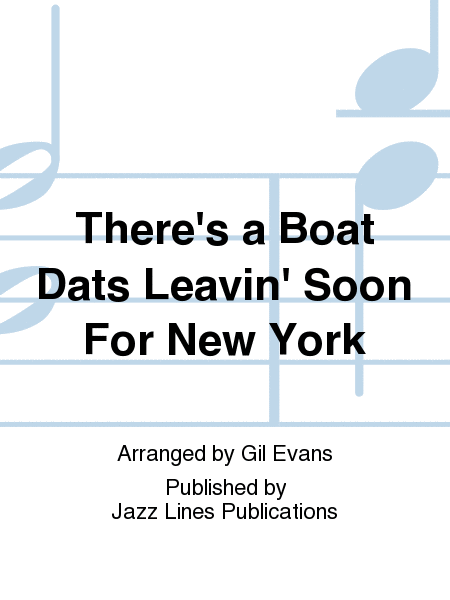There's a Boat Dats Leavin' Soon For New York
As Recorded by Miles Davis and Gil Evans on 1958's Porgy and Bess
-
Ships in 2 to 3 weeks
Details
Description
SKU: JL.JLP-7557
As Recorded by Miles Davis and Gil Evans on 1958's Porgy and Bess. Edited by Dylan Canterbury, Rob DuBoff, and Jeffrey Sultanof. Arranged by Gil Evans. Range: Trumpet 1: D7 (6 ledger lines); Trombone 1: F5. Swing. Score and parts. Published by Jazz Lines Publications (JL.JLP-7557).Despite the overall optimistic nature of the song, 'There's a Boat Dats Leavin' Soon For New York' ultimately serves the role of setting up the tragic ending of George and Ira Gershwin's 'Porgy and Bess.' After Porgy is arrested for killing Bess's former boyfriend Crown while defending her, drug dealer Sportin' Life successfully seduces Bess into leaving Catfish Row with him to embark on an adventure to New York City. Sportin' Life's promises of fun and excitement are very accurately reflected in Gil Evans' arrangement right from the start. The melody is stated by the trio of solo trumpet, alto saxophone and trombone, with the rest of the ensemble providing appropriately excited and upbeat accompaniment throughout the melody. One of the more clever moments of this arrangement comes at measure 36, where Evans makes a reference to an earlier movement, 'Gone, Gone, Gone,' in the brass that serves as a send off back to the melody. A brief but powerful ensemble blast followed by a drum break sets up an improvised trumpet solo at measure 57, with some slightly foreboding backgrounds in the woodwinds and trumpets that eventually lead up to a bombastic brass blast featuring some high note trumpet acrobatics. After a brief held tone, the trumpet soloist improvises over the song's final A section before an ensemble shout chorus begins at measure 89. This shout is undeniably difficult, and will require a significant amount of attention in order to execute properly. The trumpet soloist returns for an improvisation on the bridge, with some more intense backgrounds that ultimately lead up to another powerful brass blast at measure 119. After one final send-off, the trio of trumpet, alto saxophone and trombone resume melody duties for the final A section. The trumpet soloist resumes improvising at measure 138 as the orchestra continues to build to a thrilling climax underneath. The final chord, perhaps keeping in mind the tragic events in Porgy's life that are to come, is jarringly ominous, and should taper off rapidly to a near whisper.

 Share
Share